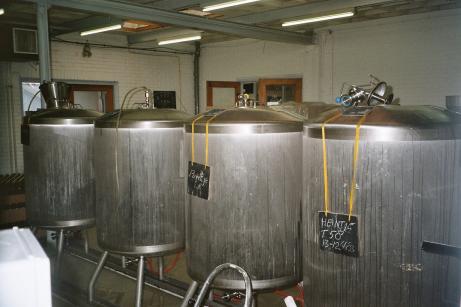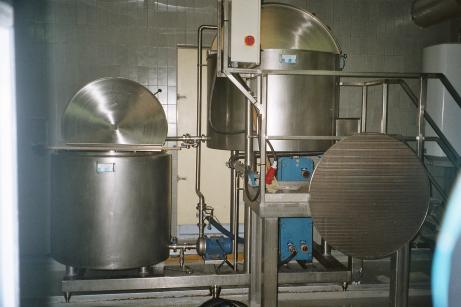 I
first visited Amsterdam's "De Prael" brewery when it was the emergency venue
for the 2003
Meibock Festival. Distracted by some Klosterbraeu, I didn't get to look
around. I was glad of a chance to make amends.
I
first visited Amsterdam's "De Prael" brewery when it was the emergency venue
for the 2003
Meibock Festival. Distracted by some Klosterbraeu, I didn't get to look
around. I was glad of a chance to make amends. My guide around the compact brewhouse is one of the co-founders, Arno Kooij. He explains how it was assembled. "The lagering tanks came from a bankrupt German brewpub. We got the fermenters from a dairy." Only the mash tun and copper - actually stainless steel like everything else - were purpose-built. Even they contain some recycled parts.
"We brew two batches of 500 litres each week. Lagering capacity is our big problem." Arno tells me. "It's only 2,000 litres at present. Next month we're getting two new tanks and that will put it up to 3,000." Last year they brewed about 420 hl . "It would be nice to brew more, but I wouldn't want to go past 600 hl." Few Dutch breweries are smaller.
 Weaker
beers stay in the tanks for 10 to 14 days. Stronger ones remain for a month.
After bottling, the beers condition for a further week at room temperature.
The regular brews alone keep the tanks full. "Extra capacity will give us
more flexibility - to contract brew, for example." Het Snaterende Arend
- a roving brewery - has already made use of their kit.
Weaker
beers stay in the tanks for 10 to 14 days. Stronger ones remain for a month.
After bottling, the beers condition for a further week at room temperature.
The regular brews alone keep the tanks full. "Extra capacity will give us
more flexibility - to contract brew, for example." Het Snaterende Arend
- a roving brewery - has already made use of their kit. I notice a handpump. Arno tells me they just use it for pumping disinfectant. But he is a fan of cask ale. "I love handpumped beer. But in Holland, people don''t understand it. They think it's flat. Everyone expects beer to be full of CO2. It's a shame, but we can't ignore our customers."
The story of how the brewery was financed intrgues me. "I was employed in a rehabilitation centre, helping recovering psychiatric patients look for work. Finding anything suitable was difficult." Starting his own business seemed the solution. He knew that there were government grants for projects aimed at employing such people.
 "Fer
(Kok, co-founder) and I had long wanted to start our own brewery, but we
didn't have the money. This seemed like a good way to get hold of it." The
grant paid the costs of the brewing equipment. Once up and running, the
brewery has had to pay its own way.
"Fer
(Kok, co-founder) and I had long wanted to start our own brewery, but we
didn't have the money. This seemed like a good way to get hold of it." The
grant paid the costs of the brewing equipment. Once up and running, the
brewery has had to pay its own way. They have a surprisingly large workforce - 32 part-timers and 3 full-timers. "The brewery is very labour intensive, but we prefer it that way. We feel that it gives us more control" .
Both Fer and Arno were keen home brewers. The recipes of all three regular beers have their origin the pair's kitchens. Nowadays, Fer does most of the brewing and formulates the recipes. Arno is more involved in the sales side of the business.
"It isn't difficult finding outlets for our beer. The trouble is keeping them." Publicans will only take beers as a guest. "Most pubs buy everything from one of the big brewers. It's easier for them. Landlords can't be bothered dealing with more than one supplier." They do have a few regular outlets in Amsterdam - Cafe Belgique, Wildeman, Arend's Nest (well-known specialist beers bars), Cafe Boulevaard (Cruquiusweg) and Elsa's Cafe (Middenweg).
 Sales are split abot 50 - 50 between draught and bottled. I ask Arno what
bottle sizes they use. "German half litres and now 33 cl bottles as well.
The people in Scotland insisted on them." This is unexpected, do they export
to the UK? "There's a project similar to ours in Scotland (Forth Sector
in Edinburgh). They run a hotel and a wholesalers. A brewery was planned,
but it was too expensive. So they asked us to supply them." Johnny has been
sold on draught in The Lowlander in Covent Garden (36 Drury Lane).
Sales are split abot 50 - 50 between draught and bottled. I ask Arno what
bottle sizes they use. "German half litres and now 33 cl bottles as well.
The people in Scotland insisted on them." This is unexpected, do they export
to the UK? "There's a project similar to ours in Scotland (Forth Sector
in Edinburgh). They run a hotel and a wholesalers. A brewery was planned,
but it was too expensive. So they asked us to supply them." Johnny has been
sold on draught in The Lowlander in Covent Garden (36 Drury Lane). Arno recalls problems with the town planners. The bureaucrats were worried about the width of the street. Sited in a light industrial estate by the motorway, I wouldn't have expected any trouble on that count. "It was difficult to persuade them that we wouldn't have juggernauts delivering our bottles. They must have been thinking of the old Heineken brewery".
Last summer they had problems with their yeast. "We used to buy it in Holland. They couldn't supply it in dried form, so we had to harvest yeast from the fermenters and repitch it. It worked fine for more than a year. Then we started getting infection problems, when the weather was very warm. We had to find a new source."
Surprisingly, the new yeast doesn't come from Holland or Belgium, but England. As before, two different strains are employed, a wheat beer yeast for Heintje and Andre and an ale yeast for all the others.
I ask Arno if he had considered using a Bavarian yeast for his wheat beer. "No. It would taste like a German beer and we don't want that."
The first brews with the new ale yeast revealed an unexpected problem: they were less bitter. "The old yeast added bitterness. We'll have to modify our recipes, putting up the EBC from 29 to 35. Though we have to be careful that they don't become too hoppy. The bitterness you get from yeast is quite different."
Here is obviously a man with a strong emotional ties to his products. "It was painful to see the flavour of our beers change, but we had no choice. The character of Johnny was more individual with the old yeast."
All the beers are bottle-conitioned and are named after Dutch singers. The ones responsible for the awful stuff they play in many Amsterdam pubs. I don't mention my opinion of this type of music to Arno. He's a nice guy and I don't want to fall out with him.

Three beers are brewed year round.
Johnny is a bitter 5.7% ale.
Heintje - 5.4% - smelling of lemon and wheat, is slightly sour with a hint orange. It's a pleasant, fruity wheat beer, which is not spiced.
Mary is a strong (9.6% !), amber ale., which could be described as a barley wine . Brewed from three types of malt, it's spiced with orange and coriander. Lingering pepper and black toffee flavours balance an initial malty sweeetness.
There are four seasonal beers.
In winter there's an 8.5% Dubbel called Willy and a 7.5% Tripel, spiced with coriander, called Willeke. Andre, a pale Maibok of 6.8% is brewed in spring and Nelis, a 7.7% dark Bok, in the autumn.
Helicopterstraat 13 - 15,
1059 CE Amsterdam.
info@deprael.nl
http://www.deprael.nl/
Visits by appointment only.
The 2004 Meibock Festival will take place in the brewery on Sunday 25th April.
36 Drury Lane,
WC2B 5RR
location: Covent Garden
phone: 020 7379 7446
email:info@lowlander.com
web site:www.lowlander.com
Unit 1 Block 3 Peffermill Industrial Estate
12 Kings Haugh
Edinburgh EH16 5UY
Tel: 0131 539 7374
Fax: 0131 539 7375
e-mail: info@forthsector.org.uk